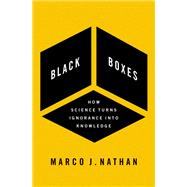
Black Boxes How Science Turns Ignorance Into Knowledge
by Nathan, Marco J.-
 eCampus.com Device Compatibility Matrix
eCampus.com Device Compatibility Matrix
Click the device icon to install or view instructions
Buy New
Rent Textbook
Rent Digital
Used Textbook
We're Sorry
Sold Out
How Marketplace Works:
- This item is offered by an independent seller and not shipped from our warehouse
- Item details like edition and cover design may differ from our description; see seller's comments before ordering.
- Sellers much confirm and ship within two business days; otherwise, the order will be cancelled and refunded.
- Marketplace purchases cannot be returned to eCampus.com. Contact the seller directly for inquiries; if no response within two days, contact customer service.
- Additional shipping costs apply to Marketplace purchases. Review shipping costs at checkout.
Summary
This book explores an original conception of the nature and advancement of science. Marco J. Nathan's proposed shift brings attention to a prominent, albeit often neglected, construct--the black box--which underlies a well-oiled technique for incorporating a productive role of ignorance and failure into the acquisition of empirical knowledge. The black box is a metaphorical term used by scientists for the isolation of a complex phenomenon that they have deliberately set aside or may not yet fully understand. What is a black box? How does it work? How do we construct one? How do we determine what to include and what to leave out? What role do boxes play in contemporary scientific practice? Nathan's monograph develops an overarching framework for thinking about black boxes and discusses prominent historical cases that used it, including Darwin's view of inheritance in his theory of evolution and the "stimulus-response model" in psychology, among others. By detailing some fascinating episodes in the history of biology, psychology, and economics, Nathan revisits foundational questions about causation, explanation, emergence, and progress, showing how the insights of both reductionism and antireductionism can be reconciled into a fresh and exciting approach to science.
Author Biography
Marco J. Nathan is Associate Professor and Chair in the Department of Philosophy at the University of Denver. His research focuses on the philosophy of science, with particular emphasis on biology, neuroscience, cognitive neuropsychology, and economics. He has published numerous articles and chapters in philosophical and scientific venues.
Table of Contents
Contents
Preface
Chapter 1: Bricks and Boxes
1.1 The Wall
1.2 A Theory of Everything?
1.3 Pandora's Gift to Science: The Black Box
1.4 Structure and Synopsis
1.5 Aim and Scope
Chapter 2: Between Scylla and Charybdis
2.1 Introduction
2.2 The Rock Shoal and the Whirlpool
2.3 The Rise and Fall of Classical Reductionism
2.4 Antireductionism Strikes Back
2.5 The Reductionists Return
2.6 Scylla or Charybdis?
2.7 Why Not Have the Cake and Eat It Too?
Chapter 3: Lessons from the History of Science
3.1 Introduction
3.2 Darwin's Quest for Inheritance and Variation
3.3 Mendel's Missing Mechanisms: A Tale of Two Syntheses
3.4 Absent Minded: Psychological Behaviors
3.5 The Nature and Significance of Economics
3.6 The Many Faces of Black Boxes
Chapter 4: Placeholders
4.1 Introduction
4.2 Two Theses About Fitness
4.3 Are Dispositions Explanatory?
4.4 Placeholders in Scientific Theory and Practice
4.5 Two Types of Placeholders
Chapter 5: Black-Boxing 101
5.1 Introduction
5.2 Step One: The Framing Stage
5.3 Step Two: The Difference-Making Stage
5.4 Step Three: The Representation Stage
5.5 What is a Black Box? A Three-Part Recipe
Chapter 6: History of Science 'Black-Boxing Style'
6.1 Introduction
6.2 Darwin's Black Boxes
6.3 Mendel's Black Boxes
6.4 Skinner's Black Boxes
6.5 Friedman's Black Boxes
6.6 Black Boxes in Science: Concluding Remarks
Chapter 7: Diet Mechanistic Philosophy
7.1 Introduction
7.2 The New Mechanistic Philosophy
7.3 Three Steps: A Neo-Mechanistic Perspective
7.4 Mechanisms, Models, and Metaphysics
7.5 Mechanisms and Black Boxes
7.6 What's in a Mechanism?
7.7 The Diet Recipe: Concluding Remarks
Chapter 8: Emergence Reframed
8.1 Introduction
8.2 Emergence: Metaphysical or Epistemic?
8.3 Emergence in Action: Systems Neuroscience
8.4 Emergents and Black Boxes
8.5 Refinements and Implications
8.6 Adequacy Conditions and Advantages
8.7 Concluding Remarks
Chapter 9: The Fuel of Scientific Progress
9.1 Introduction
9.2 The Roots of Incommensurability
9.3 Referential Models and Incommensurability
9.4 Black Boxes and Reference Potential, Part I
9.5 Black Boxes and Reference Potential, Part II
9.6 Incommensurability, Progress, and Black Boxes: Concluding Remarks
Chapter 10: Sailing Through the Strait
10.1 Back to Bricks and Boxes
10.2 The Quagmire
10.3 Rocking the Rock, Weathering the Whirlpool
10.4 A History of Black Boxes
10.5 The Devil in the Details?
References
An electronic version of this book is available through VitalSource.
This book is viewable on PC, Mac, iPhone, iPad, iPod Touch, and most smartphones.
By purchasing, you will be able to view this book online, as well as download it, for the chosen number of days.
Digital License
You are licensing a digital product for a set duration. Durations are set forth in the product description, with "Lifetime" typically meaning five (5) years of online access and permanent download to a supported device. All licenses are non-transferable.
More details can be found here.
A downloadable version of this book is available through the eCampus Reader or compatible Adobe readers.
Applications are available on iOS, Android, PC, Mac, and Windows Mobile platforms.
Please view the compatibility matrix prior to purchase.

